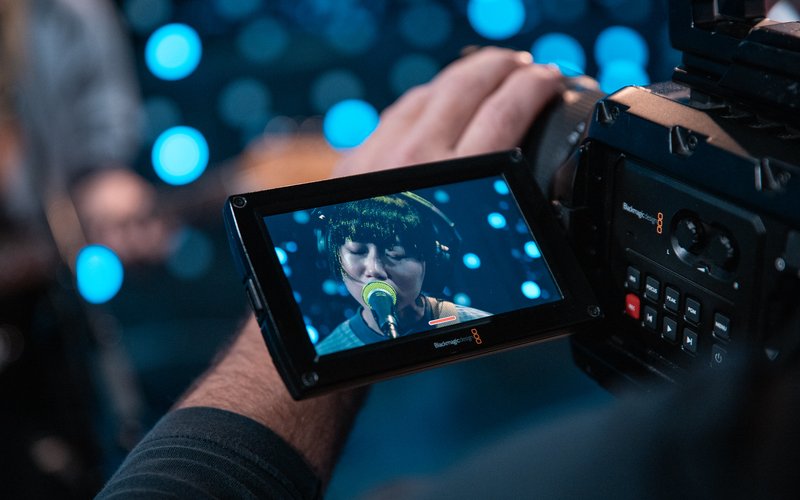
The future of live music is not looking bright, thanks to the coronavirus and the resulting stay-at-home order. Experts foresee a continuance of social distancing, even once the order is lifted, and in a recent roundtable for the New York Times, Center For American Progress oncologist and bioethicist Zeke Emanual advised that large gatherings like concerts not return until "fall 2021, at the earliest."
Throughout this period of self-quarantine, many musicians have turned to live streaming their musical performances to stay connected to fans and even make some money to compensate for cancelled tours. (You can see KEXP's recommended list of these upcoming online concerts here.) If you're an artist, you might be wondering how you can do the same thing, especially if you've never streamed a concert from your home before. Well, we asked KEXP's renowned video team for their guidance and advice. After all, who would know better how to capture a live performance? (Two million YouTube subscribers can't be wrong!) The KEXP Video Team (Jim Beckmann, Justin WIllmore, Alaia D'Alessandro, and Scott Holpainen) shares their tips below.
First off, you're going to want to choose (and clean!) a location to perform from. "Set up your space how you like, find an interesting background, use nice lighting (here is a helpful article on three-point lighting), take your time, make it unique and memorable," the team advises. Don't have any good lighting? "Daylight is your friend, setting up where you can use natural light will make your video look better," they suggest. "If you don’t have any lights, a cheap china ball is great to have around."
Make sure the location you choose doesn't sound too echo-y. That's right, the bathroom is probably not the best place to set up, unless that, well, works for your aesthetic. (Watch Stephin Merritt of the Magnetic Fields perform live on KEXP from the bathroom in our old home below.) Plants, curtains, rugs, and other soft things can help absorb the sound.
That's right, there ain't no roadies in quarantine, so, get to it. "Place your microphone," begins Wilmore. "If you just have one, place it somewhere close to all the sounds you are making. If you are singing and playing a guitar, put your mic somewhere in the middle between your voice and the guitar. Experiment with what sounds good. Here’s a good article about mic-ing tips for various instrumentation."
Up next, soundcheck. "If you have recording software like Garageband (or download Audacity for free) you can record yourself and listen back to how it sounds before you go live and make adjustments." the team continues. "Consider using a mixer if using more than one microphone, use signal processing if possible (eq, compression, reverb, delay). An audio interface like this would be a cheap and easy way to run your mix into your phone or iPad. Don’t be afraid to just use one microphone if that’s all you have. Work with what you got. Once your mix is dialed in, you are ready to stream."
"There’s a variety of cameras you can work with," suggests Wilmore. "A camcorder is a good option, but SLR cameras have mostly taken over and it has become affordable to record high quality video." If all you have if your laptop camera or phone, that will work, too. "A small tripod or even a relatively inexpensive gimbal will help keep your video in place," he advises.
No matter which kind of filming equipment you use, you'll want to be conscious of camera placement. "You will need to work with what lens you have, but try to keep your camera at eye level," Wilmore recommends. "Too high and it feels awkward to watch; too low and you are just giving people a shot of the inside of your nose." He continues, "Make sure people can see your instrument. People want to see your sweet guitar, piano, knob-twiddling, or accordian playing."
The following platforms are the ones Wilmore recommends. The video team also adds, "If you live stream on one of these platforms, consider uploading your video to the others after you are done. You can even pull the video into iMovie and add a title, song titles, links to social media accounts."
For many musicians, playing live is a major source of revenue. This can still be true online, if not at a club.
Unless you're using Twitch, you'll need to set up a way for people to give you money. If you don't have accounts at these sites already, take the time to open PayPal and Venmo accounts to allow fans to "tip" you during your performance. Share links for donations in the description field of your video, as well as on your social media accounts and website.
Take advantage of the captive audience by sharing the URL for your Bandcamp page to buy albums or other merchandise. You can even hold up your t-shirts and tote bags to the camera to show viewers what you've got available.
Also, be sure to ask viewers to either follow you on social media or sign up for your mailing list, if you have one. You want to make sure you can stay in touch with them even once the clubs re-open.
Artists will receive 100% of all profits to support those affected by coronavirus lockdowns.
KEXP presents a series rounding up some of the most interesting band merch we can find, helping you support your favorite bands during this time of staying home.
Sound & Vision host Emily Fox spoke with members of the newly formed Washington Nightlife and Music Association about the current state of music venues amid long term closures due to COVID 19.